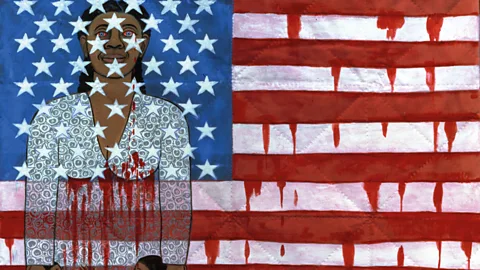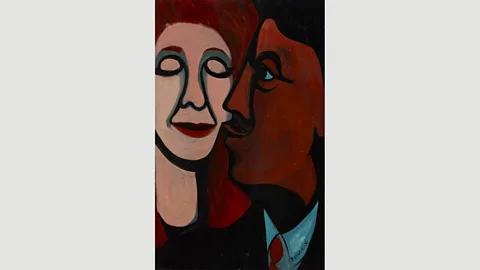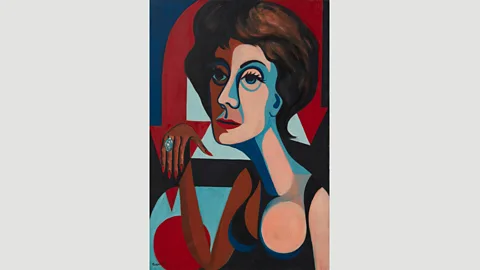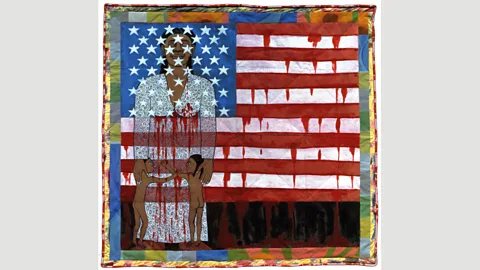Faith Ringgold: The artist who captured the soul of the US
 2018 Faith Ringgold/Artists Rights Society (ARS
2018 Faith Ringgold/Artists Rights Society (ARSThe pioneering artist, who died on Saturday, was an outspoken campaigner for justice. In 2019, she spoke to the BBC about her early life, and how she created subversive work with postage stamps and story quilts.
“As an artist, I want to tell my story of the times – what I’ve lived through; what we’re going through now. Often, people don’t want to see that… but I don’t do what people want to see; I do what I can.”
These days, crowds at major galleries clamour to see the work of Harlem-born painter/sculptor/writer and performance artist Faith Ringgold – who died on Saturday. But the artist fought hard throughout her life for that platform. Ringgold’s art is vivid and far-ranging (embracing over a dozen media, from her trademark narrative-based ‘story quilts’ to iconic masks and stained glass); it captures the soul of the US – its pop culture and politics – and lays it bare. It is fantastically vivacious, but also frequently speaks deeply uneasy truth to power.
Over the past decade, there has been a kind of mainstream awakening; Ringgold has proved a stand-out at acclaimed group shows including Tate Modern’s Soul Of A Nation: Art In The Age Of Black Power (2017), and inspires dedicated exhibitions. Her high-profile fans include Oprah Winfrey, Bill Clinton and the late Maya Angelou. A celebration of Ringgold’s art – with many previously unseen works – showed in 2019 at London’s Serpentine Gallery; it was, Ringgold told the BBC, “a survey, not a retrospective”.
 2018 Faith Ringgold/Artists Rights Society (ARS
2018 Faith Ringgold/Artists Rights Society (ARSIn the 2004 book A View From The Studio (with Curlee Raven Holton), she explains: “I grew up in Harlem during the Great Depression. This does not mean I was poor and oppressed. We were protected from oppression and surrounded by a loving family.” Her neighbourhood was also home to the visionary jazz artists and poets that had fuelled the Harlem Renaissance; local legends like Langston Hughes and Duke Ellington were family friends. Ringgold’s mother, a talented seamstress and fashion designer, would later help her to develop the concept of ‘story quilts’: a portable alternative to large heavy canvases, ornately decorated, and updating a US folk-craft tradition with sharply modern statements.
 2018 Faith Ringgold/Artists Rights Society (ARS
2018 Faith Ringgold/Artists Rights Society (ARSAged 88, Ringgold spoke to the BBC in warmly upbeat tones; elegant yet steely, and also unmistakeably no-nonsense, exclaiming with a laugh: “In my family, there was no such thing as: ‘you can’t do that’… ‘yes, you can!’” In 1950, Ringgold became the first black scholar and woman to study art at the City College of New York (before her, only white men had been admitted to its ‘liberal arts programme’).
Mainstream exclusion – and an eloquent, fearless response to it – has been a defining theme of Ringgold’s art. At school, she’d been struck by Horace Pippin’s 1942 painting John Brown Going To His Hanging, before finding out that Pippin was an African-American artist: the only one featured in her history books.
“There was so much creativity around me: music, art, dance,” she told the BBC. “But there was also the fact that as black people, we were denied a position in the art world. Why was that happening? And are you going to let other people decide, or persevere?”
 Faith Ringgold/Artists Rights Society (ARS
Faith Ringgold/Artists Rights Society (ARSThe 1960s brought crucial turning points – including the 1964 US Civil Rights Act, which finally ended segregation in public spaces – and that creatively febrile, socially turbulent era also sealed the activist spirit of Ringgold’s art. “The ‘60s were so vibrant,” she enthused. “It was a period where everything was happening, every day. I caught everything I could – but I also got left out of all the shows.
“It was very difficult, but I didn’t know anything else. And I was able to create my art without any restrictions. Once you create an image, even if not many people see it, it’s a permanent form of expression.”
Brutal beauty
Ringgold’s expressions became increasingly visceral, in reaction to the US struggle for racial equality. There’s a devastating blend of beauty and brutality, and a righteous fury to key works such as Die (1967): its sprawl of bodies is reminiscent of Picasso’s Guernica (which Ringgold would often visit at NY’s Museum of Modern Art); in the midst of the violence are two kids – one black, one white – sheltering each other in a terrified embrace.
“Oh my God, I’d think about what upsets me about these riots that they weren’t even reporting,” recalled Ringgold. “I’d get home, and people would be listening to the radio, but they hadn’t heard anything – and there’s blood on the streets!” She admitted: “When I started painting the blood, it was scary. I knew that I was painting death.”
 2018 Faith Ringgold/Artists Rights Society (ARS
2018 Faith Ringgold/Artists Rights Society (ARSAt the same time, her art has presented an irrepressible life force, even if mainstream institutions were initially closed off to it; she mentioned that she (unsuccessfully) tried to donate Dieto museums – it eventually sold, in 2011. Back in 1971, Ringgold endured a racial slur from a white male passer-by outside NY’s Whitney Museum, where she was participating in an anti-discrimination protest – she painted Hate Is A Sin Flag (smartly subverting the confederate design) in response; decades later, the piece was purchased and proudly displayed by the Whitney. In fact, Ringgold never really adhered to any conventions; her ‘Free Angela’ poster (1971) for activist party the Black Panthers was never produced – though she did eventually give a print to Angela Davies in person. “Just because they were political in their way, doesn’t mean that they accepted my visual expression,” she said.
 2018 Faith Ringgold/Artists Rights Society (ARS
2018 Faith Ringgold/Artists Rights Society (ARSThere’s a current trend for socially conscious kids’ storybooks; Ringgold was writing and illustrating her own decades ago, including the autobiographical Tar Beach (with its recurring motif of a young girl with unconstrained dreams – soaring high above New York’s rooftops), and historical epic Aunt Harriet’s Underground Railroad In The Sky (paying homage to heroic slave abolitionist/activist Harriet Tubman). We Came To America portrays the racial diversity and immigrant experience that really shaped the US.
Even through its most unsettling themes, Ringgold’s art has always been pitched at the heart of the nation – whether she was using a postage-stamp design to commemorate black power (1967), or displaying her work in public spaces: her larger-than-life jazz-dance frieze Groovin’ High (1987, inspired by Dizzy Gillespie) was shown above NYC’s High Line, and the joyous mosaic design of Flying Home appeared inside 125th Street subway station (depicting Harlem luminaries soaring past landmarks such as the Apollo Theatre). Her multi-media flair has extended to indie-games design (the lushly-hued Quilt Sudoku app).
“Old is phenomenal today!” she declared. “There’s so many old people in the world, and I’m one of them – I wanna be out there, producing art!” The power of perseverance is timeless; for Ringgold, the soul of America remained boundless.
A version of this article was published in 2019.
And if you liked this story, sign up for the weekly bbc.com features newsletter, called The Essential List. A handpicked selection of stories from BBC Future, Culture, Capital and Travel, delivered to your inbox every Friday.
